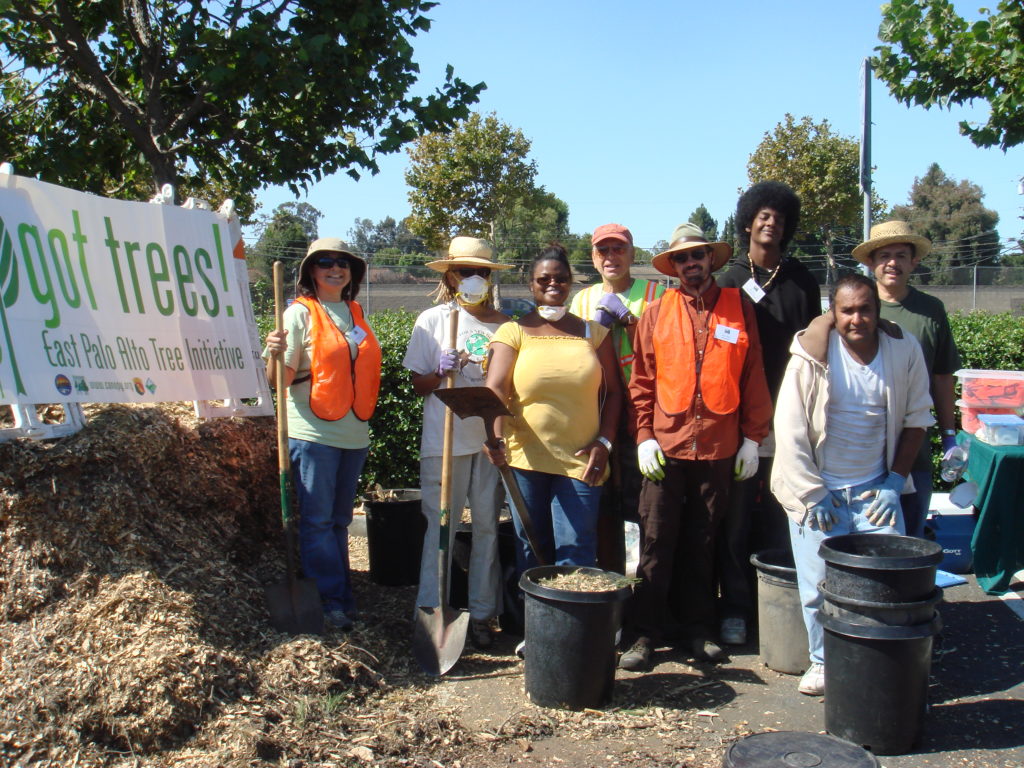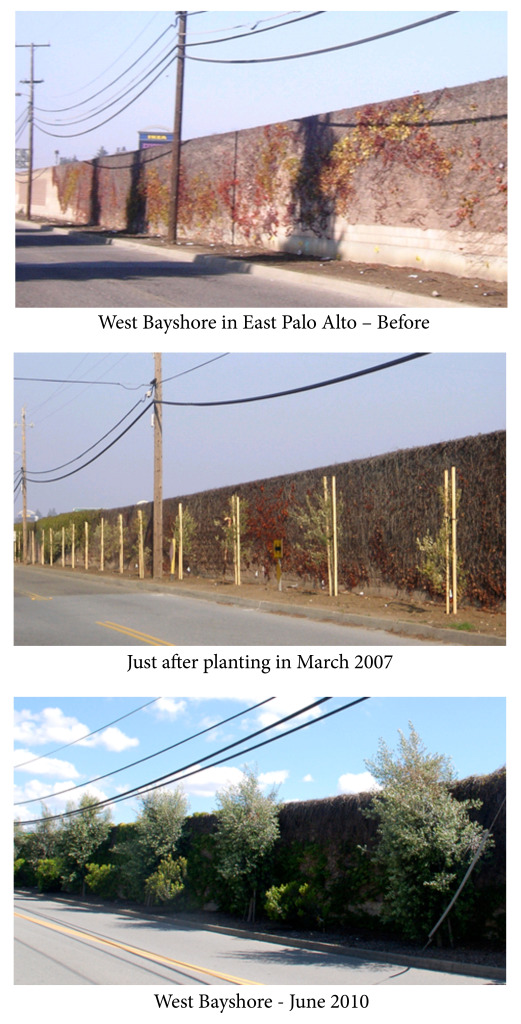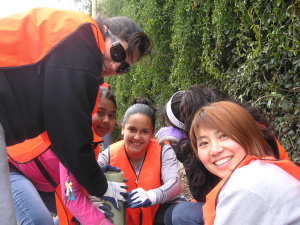- About Us
- Our Work
- Tree Info
- Get Involved
- Blog
- Support Us

A community’s environmental quality profoundly impacts the well-being of its residents. People’s health, education, and economic prosperity are all influenced by what they encounter when they step outside.
This is why Canopy’s mission is to plant trees where they are most needed: because healthy, thriving communities depend on a healthy, thriving environment. Trees are a critical element of our urban environment, providing life-giving benefits from cleaner air and water to reduced stress and increased property values.
In 2005, Canopy began an important partnership with East Palo Alto, a community with engaged citizens and strong social fabric, but beset by economic and social challenges, and with a notable lack of trees and urban green space.
In collaboration with Cal Fire and the City of East Palo Alto, Canopy launched the East Palo Alto Tree Initiative (EPA-TI) with a goal of enhancing the community’s urban forest by planting more than 1,000 trees in key areas.
Dave Muffly, Board Certified Master Arborist and Canopy Board member emeritus, designed the ambitious planting. Muffly selected more than 20 tree species, taking care to satisfy multiple criteria, from drought tolerance to suitability for overhead utilities. He also incorporated native and rare oak species not frequently found elsewhere.
With plans complete, the very first trees were planted in April of 2006. During the launch ceremony, visiting Nobel Peace Laureate Wangari Maathai praised the community for their investment. “I am happy to join you in launching the campaign to plant trees in East Palo Alto,” she stated. “I will keep writing back to find out how far you have gone. I want to know of your progress because, here on this beautiful Sunday afternoon, East Palo Alto has changed and become a truly green city.”
You can watch Wangari giving her inspiring speech in East Palo Alto in the video to the left. The site of this first planting was developed into a finished neighborhood park, now referred to by many as the Wangari Maathai Grove.
In addition to neighborhood parks, several areas throughout the city were identified as priority planting zones. The largest were four stretches of the Highway 101 Sound wall stretching along East and West Bayshore road, totaling 2.1 miles of roadway between San Antonio and Willow.
Between 2007 and 2008, nearly 900 trees were planted along these stretches, some from acorns or seedlings, others from larger #15 containers. Thanks to a grant form Cal Fire, temporary irrigation was installed along to help establish the trees and ensure vitality.
Additionally, more than 300 trees were planted along University Avenue, on the center median on Newbridge Street, and in parks throughout East Palo Alto.
As these young trees grow, they will increasingly muffle highway noise and filter particulate pollution from cars. Evergreen trees planted in rows—like the ones along the sound wall–can capture up to 85% of air pollution particles blowing through their branches. With the right care, East Palo Alto’s new urban forest will grow to provide the community with numerous social, environmental and economic benefits.
 The results: an enduring community investment
The results: an enduring community investmentAll told, more than 1,200 trees were successfully planted and established in key areas of East Palo Alto, more than a year ahead of the target completion date. At every stage of the process, from planning to planting to ongoing maintenance, East Palo Alto residents and partners were integral to success.
East Palo Alto City officials supported the project and helped spread the word. Local school children planted acorns and seedlings. Community members prepared planting sites, dug holes, and worked tree roots prior to the planting. High school groups came out to mulch and weed to keep the newly planted trees healthy. Since 2008, Canopy’s Teen Urban Foresters (formerly Youth Tree Corps or Youth Staff) and volunteers have spent hours clearing ivy, weeding, and performing clearance pruning. The City maintenance crews have stepped in to support the effort, and will soon take over caring for the trees.
Overall, the community contributed more than 4,000 hours of work hours to enhance the urban forest. Along the way, they learned the importance of city trees and created a lasting sense of community pride and ownership.
See a map of Canopy’s plantings in East Palo Alto![]() .
.
Local youth played an especially important role in the project. In partnership with JobTrain, Canopy created the EPA-TI Youth Program to involve young adults from East Palo Alto in the initiative. The program offers part-time employment to underserved youth and is designed to encourage leadership and tree stewardship. Before the planting, the youth staff assembled portions of the irrigation system and protective shelters for the seedlings. They were involved in all aspects of the planting and instrumental in the tree care work.
After the initiative was complete, this partnership grew into Canopy’s Teen Urban Foresters (then known at the Youth Tree Corps), which continues to employ 4-8 youth every year.
Canopy continues to partner with the City of Palo Alto to ensure the long-term survival of the young trees. All trees were carefully selected at the nursery to guarantee they were the best possible stock. Before planting, each tree’s root ball was prepared to avoid potential problems caused by circling and girdling roots. The combination of careful design and extensive pre- and post-planting care has resulted in the project’s exceptional 98% tree survival rate, which far surpasses typical industry rates. Only a few trees have been lost, most of them due traffic accidents.
Each summer since planting, Can opy has organized community volunteers to survey the health of each tree and determine whether any corrective actions are needed. These teams of trained volunteers have performed much of the tree care work, including training, pruning, weeding, mulching, and maintenance of the irrigation system. The City of East Palo Alto will assume the responsibility for long-term maintenance of the trees after Canopy’s contractual three-year maintenance commitment period expires.
opy has organized community volunteers to survey the health of each tree and determine whether any corrective actions are needed. These teams of trained volunteers have performed much of the tree care work, including training, pruning, weeding, mulching, and maintenance of the irrigation system. The City of East Palo Alto will assume the responsibility for long-term maintenance of the trees after Canopy’s contractual three-year maintenance commitment period expires.
The initial planting phase consisted of twenty different tree species, all drought tolerant. Species were all selected for their strong structural characteristics, and the fact that they will not disrupt pavement and sidewalks. Some were selected for their beautiful flowering habits, such as Marina Madrone, Strawberry Tree, and Primrose.
Nearly all species are evergreen, meaning they retain leaves or needles all year round. About one-third of the trees are oaks of several varieties.
Here is the complete list of species from the initial planting phase:
* Planted from seed/acorn
Following the success of the East Palo Alto Tree Initiative, Canopy and partners decided to keep the momentum going and plant another 1,000 trees! This time, the focus was on underserved schools. Click here to read more about the Healthy Trees, Healthy Kids! Initiative, completed in 2014.